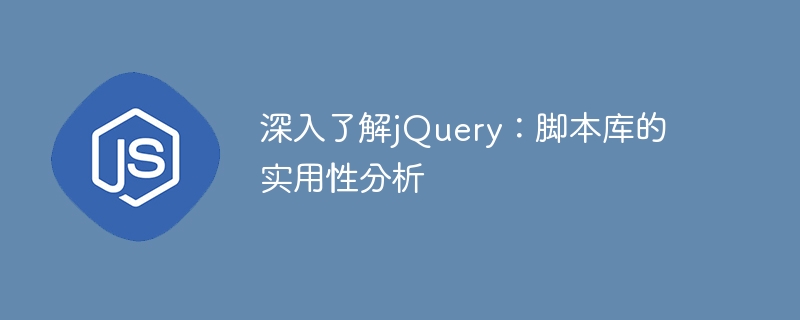Home >Web Front-end >JS Tutorial >In-depth understanding of jQuery: Practical analysis of script library
In-depth understanding of jQuery: Practical analysis of script library
- WBOYWBOYWBOYWBOYWBOYWBOYWBOYWBOYWBOYWBOYWBOYWBOYWBOriginal
- 2024-02-23 08:30:04990browse

In-depth understanding of jQuery: practical analysis of script library
Introduction:
jQuery is a widely used JavaScript library that simplifies HTML document operations and events Processing, animation effects and Ajax operations. In web development, jQuery is widely used because of its powerful functions and concise syntax, allowing developers to perform front-end development more efficiently. In this article, we will delve into the practicality of jQuery and analyze its advantages and applicable scenarios through specific code examples.
1. Advantages of jQuery:
- Concise syntax: jQuery uses concise syntax to select page elements, operate DOM and handle events, which greatly simplifies the complexity of front-end development.
- Cross-browser compatibility: jQuery solves the compatibility problem between different browsers. Developers do not need to care about browser differences, which improves development efficiency.
- Rich plug-in ecosystem: jQuery has a huge plug-in ecosystem, covering various functional modules. Developers can directly use these plug-ins to extend functionality.
- Efficient animation effects: jQuery provides a wealth of animation effects and special effects, which can make the page more vivid and dynamic.
2. The practicality of jQuery:
-
DOM operation:
With jQuery, you can easily select page elements and manipulate their content and style. For example, you can quickly obtain elements through selectors, and modify the content and style of elements through methods.// 选择元素并修改样式 $("p").css("color", "red"); // 在元素后面添加新内容 $("p").append("新内容"); -
Event processing:
jQuery provides rich event processing functions, which can easily bind events and execute event handlers. For example, a click event can be used to trigger the corresponding action.// 点击按钮触发事件 $("button").on("click", function(){ alert("按钮被点击了"); }); -
Animation effect:
Using jQuery’s animation effect function, you can add dynamic effects to page elements to improve user experience. For example, you can achieve a fade-in and fade-out effect for elements.// 淡入效果 $("div").fadeIn(); // 淡出效果 $("div").fadeOut(); -
Ajax request:
Through jQuery's Ajax function, you can load data asynchronously and interact with the server without refreshing the entire page. For example, server-side data can be obtained via Ajax requests and the page updated.// 发起Ajax请求 $.ajax({ url: "data.php", method: "GET", success: function(data){ $("div").html(data); } });
Conclusion:
jQuery is widely used in front-end development. Its concise syntax and rich functions make development more efficient and convenient. Through the analysis of this article, we can gain an in-depth understanding of the practicality of jQuery and demonstrate its advantages and applicable scenarios through specific code examples. In future front-end development, we can use jQuery more flexibly to achieve richer and dynamic page effects.
The above is the detailed content of In-depth understanding of jQuery: Practical analysis of script library. For more information, please follow other related articles on the PHP Chinese website!

